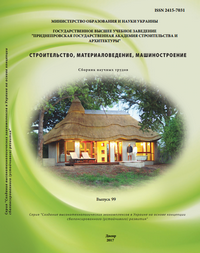Design of decorative and protective systems of buildings from autoclaved aerated concrete taking into account the parameters of comfort, environmental friendliness, economy and durability
Keywords:
walls of buildings, autoclaved aerated concrete, protective systems of buildings.Abstract
Annotation. Purpose: The external walls, made of autoclaved aerated concrete, should provide the required parameters of the microclimate of the premises while maintaining and maintaining the walls of buildings with the lowest economic costs for maintenance and repair in a condition suitable for operation. The purpose of the work is to identify the destructive factors affecting autoclaved aerated concrete, the mechanism of their impact and the rationale for the design and installation of decorative protective systems for the walls of such buildings. Technique: expert analysis of the influence of destructive factors on the durability of autoclaved aerated concrete with the use of physical chemistry, chemistry, fracture mechanics, building physics, etc. Calculation of thermo-technical parameters of the wall structure using a mathematical apparatus. Results: on the basis of understanding the processes of destruction of the wall structure, the necessity of applying decorative protective systems for the walls of buildings made of autoclaved aerated concrete, taking into account the parameters of comfort, environmental friendliness, economy and durability is substantiated. Scientific novelty: The mechanism of destruction of a wall structure made of autoclaved aerated concrete under the influence of destructive factors (humidification and drying, freezing and thawing of moisture in the material, osmotic phenomena, corrosion processes, etc.) is considered. Practical significance: Based on the analysis of the wall structure made of autoclaved aerated concrete, recommendations to builders and designers on the need for the installation of decorative protective systems for the walls of such buildings are justified.References
Akhmetov DA. Cellular concrete for enclosing products of high-rise buildings: the author's abstract. Dis ... .doc. Tech. Sciences: 05.23.05 - "Building materials and products" / Akhmetov Dmitry Anatolevich; -Almaty, 2010. -20 p .
Budnikov P.P. Air resistance of astringent materials based on lime and mineral additives. Budnikov, N.V. Ivakhno // Building materials. - 1961. - No. 5. - P. 10-12.
Grinfeld GI Engineering solutions for ensuring the energy efficiency of buildings. Finishing masonry from autoclaved aerated concrete / GI. Greenfield. - SPb .: Publishing house of Polytechnic. University, 2011. – 130 p.
Kuznetsov DV Methods of protection of exterior walls of buildings based on autoclaved aerated concrete blocks: dis. ... cand. Tech. Sciences: 05.23.05 Building materials and products / Kuznetsov Dmitry Valerevich. - Ufa, 2006. -153 p.
Paruta VAOptimization of the "clutch-covering" system operation / VA, Paruta, EV Brinzin, AVShapovalova, Yu.V. Pastushenko // Writer of the OABA, ¹35. Odesa "Mosto maystriv" -2009 - P. 265-272
Manual on external wall finishing from cellular concrete blocks of autoclave hardening / А.С. Kolomatsky, G.I. Greenfield, L.H. Zagorodniuk, S.A. Kolomatskaya and others. National Association of Manufacturers of Autoclaved Aerated Concrete in Russia. - Belgorod, 2010. -36 p.
Silaenkov E.S. Longevity of products from cellular concrete / Silaenkov Е.S. -M .: Stroiizdat, 1986. - 176 p.
Eving P.V. Economic efficiency of application and prospects of development of production of cellular concrete products / P.V. Eving // Production and application of silicate concretes: Sat. Scientific. Tr. NIPIsilicate Concrete - No. 15, Tallinn, 1976. -P.162-178
Downloads
Published
Issue
Section
License
Редакція Видання категорично засуджує прояви плагіату в статтях та вживає всіх можливих заходів для його недопущення. Плагіат розглядається як форма порушення авторських прав і наукової етики.
При виявлені у статті більш ніж 25% запозиченого тексту без відповідних посилань та використання лапок, стаття кваліфікується як така, що містить плагіат. У цьому випадку стаття більше не розглядається редакцією, а автор отримує перше попередження.
Автори, в статтях яких повторно виявлено плагіат, не зможуть публікуватися в усіх журналах Видавництва ДВНЗ «Придніпровська державна академія будівництва та архітектури».
Автори, які публікуються у цьому журналі, погоджуються з наступними умовами:
- Автори залишають за собою право на авторство своєї роботи та передають журналу право першої публікації цієї роботи на умовах ліцензії Creative Commons Attribution License, котра дозволяє іншим особам вільно розповсюджувати опубліковану роботу з обов'язковим посиланням на авторів оригінальної роботи та першу публікацію роботи у цьому журналі.
- Автори мають право укладати самостійні додаткові угоди щодо неексклюзивного розповсюдження роботи у тому вигляді, в якому вона була опублікована цим журналом (наприклад, розміщувати роботу в електронному сховищі установи або публікувати у складі монографії), за умови збереження посилання на першу публікацію роботи у цьому журналі.
- Політика журналу дозволяє і заохочує розміщення авторами в мережі Інтернет (наприклад, у сховищах установ або на особистих веб-сайтах) рукопису роботи, як до подання цього рукопису до редакції, так і під час його редакційного опрацювання, оскільки це сприяє виникненню продуктивної наукової дискусії та позитивно позначається на оперативності та динаміці цитування опублікованої роботи (див. The Effect of Open Access).

